I don’t often have an appetite when I first wake up. I tend to make breakfast to go and eat it a few hours later. This doesn’t always work for those early morning workouts. I can’t work out on an empty stomach or I’ll just drag. I need some fuel to keep me going. It’s usually a little something, and often on the go. The other day I was running late and before I knew it, I was on my drive to the gym without having eaten anything. I pulled into a gas station and hoped for the best. I should also say I’m kind of cheap when it comes to spending money on some things. Don’t get me wrong, I often splurge on quality food, but a $5 gas station protein bar? I don’t think so. Instead, I went for the cheaper option and grabbed a snickers bar. And it worked. It was just enough to get me through the workout. But was it worth it?
A Snickers bar, if you read the label, contains: milk chocolate, peanuts, corn syrup, sugar, palm oil, skim milk, lactose, salt, egg whites, and artificial flavor. Ok, there are some definite red flags in here, and no I wouldn’t recommend grabbing this regularly. Sometimes we reach for junk food and we will be ok, as long as this isn’t a staple in our diet. I highly recommend reading ingredient lists and learning to identify harmful ingredients, fillers, and things we should look out for. Sounds like another blog post in the works. But for today let’s continue to break down the Snickers bar.
A regular-size Snickers bar contains 250 calories, 12g of total fat, 125 mg of sodium, 32g of carbohydrates, 4g of protein, 28g of total sugar, and 1g of dietary fiber. As you can see this isn’t a well-balanced snack/meal. You are meeting your total saturated fat for the day, exceeding your daily sugar intake. With a measly 4g of protein this candy bar is about half sugar and half fat. Meaning yes, it did provide me with a quick burst of simple carbohydrates, enough to fuel my workout but it also contained a high amount of fat in one serving. Unless I’m about to do a solid workout this certainly would not be a choice snack. It’s hardly a choice pre-workout snack. According to calculations, It’ll take about 40 minutes of moderate biking to burn off the calories in one snickers bar.(1) Depending on what your workout goals are this might be a bigger setback than it’s worth. On this day, I was in a pinch and I needed fuel. My current goals with workouts are not about fat loss so I was ok with this choice on this day. Would I do this every day? No, and I’ll admit after writing this I might reach for my all-time favorite candy bar far less often.
So why does Snickers really satisfy?
It contains all the elements that create a dopamine hit in our brain: sweet, salty, and fat. These three are the most desirable flavors. “Foods high in sugar, fat, and salt promote more arousal, more thoughts of food, more dopamine-stimulated approach behaviors, more consumption, more reward, more habit-driven behavior, and ultimately, more and more weight gain.”(2) That is conditioned hyper eating, and American marketing preys on this. Creating hyper-palatable products that drive the reward response in our brain, continuing the cycle.
How can we break the cycle?
It takes small changes to make big differences. It’s been said it can take at least three weeks to break a habit and form a new neural pathway. (3) You can start by avoiding those high-fat, high-sugar, prepackaged snacks and bars and on-the-go foods. Yup, I’m talking to myself here as well. I could have easily created the same quick burst of on-the-go fuel with a spoonful of peanut butter, and 1/2 a banana on a slice of sprouted whole-grain bread. Half the fat, double the protein, same amount of carbohydrates plus the added benefits from fiber versus the simple sugars, and “empty calories” found in the Snickers bar.
The lesson here is, although it’s easy to grab a prepackaged burst of fuel to get you through that workout, is it worth it? Are those ingredients really what you need or just sugar and fat in a fancy wrapper? By keeping your pantry stocked with whole foods that you can easily pair together you can easily make a healthy, nutrient-dense pre-workout breakfast and avoid that bar in a wrapper.
Resources:
- Cronometer.com
- David Kessler. The End of Overeating: Taking Control of the Insatiable American Appetite. 1. Emmaus, PA: Rodale Press; 2009.
- Gardner B, Lally P, et al. Making health habitual: the psychology of ‘habit-formation’ and general practice. British Journal of General Practice. 2012; 62(605): 664-666.

